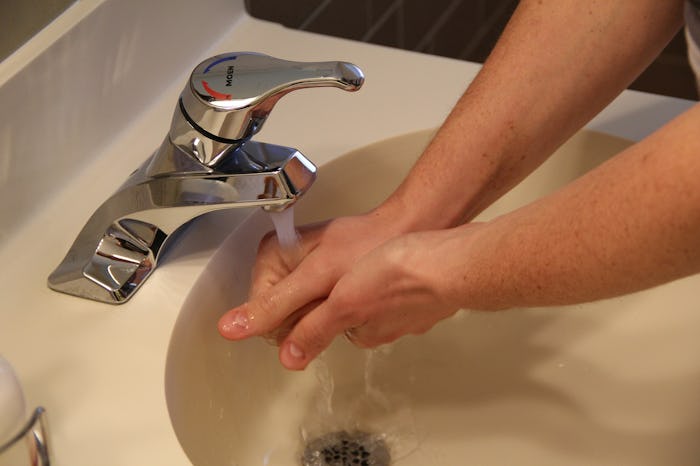You've probably seen a news story or two about an outbreak of norovirus. The winter vomiting bug has caused a bit of a panic among health officials and moms alike because it is so contagious. But some of the news spots on norovirus have been a bit vague about what norovirus is and how you catch it. So here is an explanation about what the norovirus is, with some helpful tips from professionals on keeping yourself protected.
Norovirus causes gastroenteritis, which is an inflammation of the stomach or the intestines, according to the CDC. The most common symptoms of norovirus are diarrhea, throwing up, nausea, and stomach pain. Anybody who has had food poisoning knows how miserable and uncomfortable these symptoms are, and norovirus is like the worst case of food poisoning you'll ever have.
But what's even worse is that some other common symptoms of the virus that sound a lot like the flu: sometimes those infected have body aches and a fever. Drinking water is essential for those who are infected with norovirus, because they need to replace the fluids lost from vomiting.
And once you've got norovirus, you're stuck with it for at least a day, sometimes up to three. No one is immune to it: not even celebrities.
If the norovirus sounds terrible, it's probably much worse than you think it is. That's because it's so easy to catch: 1 in 15 Americans catch norovirus each year, the CDC reported. Of course, if you come in contact with someone who has the virus, that will put you at risk. But even if you don't, all it takes to catch norovirus is touching a surface, such as a counter or a subway pole, that has been exposed to the virus. Unsurprisingly, norovirus outbreaks occur frequently in schools.
And the biggest culprit in spreading norovirus is food. When someone who is infected (or has recently been infected, since the virus is still highly contagious within days of a person's recovery) prepares food with bare hands, that food becomes contaminated and the person who eats it is at risk.
Restaurants have had to close thanks to norovirus infections, including several locations of Chipotle and the Wahaca chain of Mexican restaurants in the U.K.
Learning how to protect yourself against norovirus right now is especially important given the fact that most cases occur from February to April, according to this chart from the CDC:
Unfortunately, you can't use antibiotics to fight norovirus — after all, it's a virus, not a bacteria.
If you're hoping for a vaccine to come out, it turns out that may not be possible. University of Rochester Medical Center's John Treanor told NBC that the virus is hard to kill because it's a type of virus called a capsid. And unfortunately, the virus has many strains. Since the virus can mutate, creating a vaccine for one strain won't work against other strains.
The most important thing you can do to protect yourself is to wash your hands. And by "wash your hands," I don't mean rinse them in some lukewarm water for six seconds: you need to rub hard for at least 30 seconds, use really hot water and soap, and make sure you wash under your nails.
The virus also spreads via fecal matter, which makes laundry a culprit for causing infection. So if you have someone sick in your house, make sure you wash your clothes with very hot water and bleach to remove the virus. Also use bleach to disinfect surfaces such as table tops and counters that someone who is infected may have come in contact with.
And remember to be take these precautions when traveling — norovirus outbreaks are occurring in England and in several parts of Canada as well.
